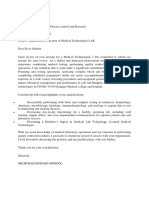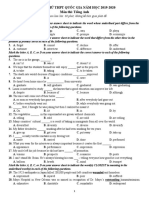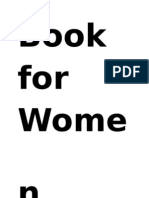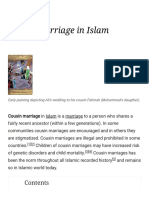0 ratings0% found this document useful (0 votes)
61 viewsFamily & Marriage: Course Code: SOC101 Course Teacher: Farhana Sultana (FNS)
Family & Marriage: Course Code: SOC101 Course Teacher: Farhana Sultana (FNS)
Uploaded by
Renjumul MofidThis document provides an overview of family and marriage from a sociological perspective. It begins by defining family and discussing different family structures. It then examines different theoretical perspectives on studying family, including functionalist, conflict, feminist, and interactionist views. Various topics related to family and marriage are also summarized, such as family organization and systems, types of marriage, economic aspects of marriage, and case studies of different marriage patterns around the world.
Copyright:
© All Rights Reserved
Available Formats
Download as PPTX, PDF, TXT or read online from Scribd
Family & Marriage: Course Code: SOC101 Course Teacher: Farhana Sultana (FNS)
Family & Marriage: Course Code: SOC101 Course Teacher: Farhana Sultana (FNS)
Uploaded by
Renjumul Mofid0 ratings0% found this document useful (0 votes)
61 views49 pagesThis document provides an overview of family and marriage from a sociological perspective. It begins by defining family and discussing different family structures. It then examines different theoretical perspectives on studying family, including functionalist, conflict, feminist, and interactionist views. Various topics related to family and marriage are also summarized, such as family organization and systems, types of marriage, economic aspects of marriage, and case studies of different marriage patterns around the world.
Original Title
1
Copyright
© © All Rights Reserved
Available Formats
PPTX, PDF, TXT or read online from Scribd
Share this document
Did you find this document useful?
Is this content inappropriate?
This document provides an overview of family and marriage from a sociological perspective. It begins by defining family and discussing different family structures. It then examines different theoretical perspectives on studying family, including functionalist, conflict, feminist, and interactionist views. Various topics related to family and marriage are also summarized, such as family organization and systems, types of marriage, economic aspects of marriage, and case studies of different marriage patterns around the world.
Copyright:
© All Rights Reserved
Available Formats
Download as PPTX, PDF, TXT or read online from Scribd
Download as pptx, pdf, or txt
0 ratings0% found this document useful (0 votes)
61 views49 pagesFamily & Marriage: Course Code: SOC101 Course Teacher: Farhana Sultana (FNS)
Family & Marriage: Course Code: SOC101 Course Teacher: Farhana Sultana (FNS)
Uploaded by
Renjumul MofidThis document provides an overview of family and marriage from a sociological perspective. It begins by defining family and discussing different family structures. It then examines different theoretical perspectives on studying family, including functionalist, conflict, feminist, and interactionist views. Various topics related to family and marriage are also summarized, such as family organization and systems, types of marriage, economic aspects of marriage, and case studies of different marriage patterns around the world.
Copyright:
© All Rights Reserved
Available Formats
Download as PPTX, PDF, TXT or read online from Scribd
Download as pptx, pdf, or txt
You are on page 1of 49
Family & Marriage
Course Code: SOC101
Course Teacher: Farhana Sultana
(Fns)
Family
• Family: a social and economic unit consisting
minimally of one or more parents and their
children.
• The members always have certain reciprocal
rights and obligations.
• The members usually live in one household
though this is not a defining feature of a
family.
What is meant by Family?
• Groups of people who are
related by marriage,
blood, or adoption and
who often live together
and share economic
resources are defined as
families.
• The family is the most
universal social
institution, but what
constitutes a “family”
varies across cultures.
Studying Family
Functionalist View: As per this view, the family
performs six paramount functions:
i. Reproduction: For a society to maintain itself, it
must replace dying members.
ii. Protection: Unlike the young of other animal
species, human infants need constant care and
economic security.
iii. Socialization: Parents and other kin monitor a
child’s behavior and transmit the norms, values and
language of their culture to the child.
Studying Family (Cont.)
iv. Regulation of sexual behavior: Standards of
sexual behavior are most clearly defined within
the family circle.
v. Affection and companionship: Family members
and relatives are expected to understand us, to
care for us when we need them.
vi. Provision of social status: Every new-born child
inherits a social position because of the family
background and reputation of the parents and
siblings.
Studying Family (Cont.)
Conflict View:
• Family is viewed as the reflection of the
inequality of wealth and power that is found
within the larger society.
• Family is also accounted for being an
economic unit that contributes to societal
injustice
Family helps to maintain inequality.
Studying Family (Cont.)
Feminist View:
• Feminist theorists have urged social scientists
and social agencies to rethink the notion that
families in which no adult male is present are
automatically a cause for concern, or even
dysfunctional.
• Feminist theorists contributed to research on
single women, single-parent households, and
lesbian couples.
Studying Family (Cont.)
Interactionist View:
• Interactionist theorists focus on how
individuals interact within the family and in
other relationships.
Studying Family (Cont.)
Theoretical Perspective Emphasis
The family as a contributor to social
Functionalist stability roles of family members.
The family as a perpetuator of
Conflict inequality Transmission of poverty or
wealth across generation.
Feminist The family as a perpetuator of gender
roles.
Female headed households.
Interactionist Relationships among family members.
Family Systems
• Nuclear family: One or both
parents and their children
• Family of orientation: The nuclear
family into which the person is
born or adopted
–When a person marries, a new
nuclear family is formed, called a
family of procreation
• Extended family: Two or more
generations
• Kinship: Network of people who
are related by marriage, birth, or
adoption
Family Organization
• Family organization is dependent on:
– Marriage Patterns
– Residential Patterns
– Descendant Patterns
– Authority Patterns
Residential Patterns
• Patrilocality: Couple lives
with or near husband’s
family
• Matrilocality: Couple lives
with or near wife’s family
• Bilocality: Couple decides
which parents to live with
or near
• Neolocality: Couple lives
apart from both sets of
parents
Descendant Patterns
• Patrilineal descent: Kinship traced through the
father’s family; property passed from father to
son
• Matrilineal descent: Kinship traced through
mother’s family; property passed from mother
to daughter
• Bilateral descent: kinship traced through both
parents; property inherited from either side of
the family
Authority Patterns
• Patriarchy: father holds
most of the authority
• Matriarchy: mother
holds most of the
authority
• Egalitarian: mother and
father share authority
What is Marriage?
• A socially approved sexual and
economic union, usually between a
woman and a man.
Characteristics of Marriage
Marriage:-
• is presumed to be more or less permanent.
(Stephens 1963)
• unites the economic and the social. (Murdock,
1949)
• is universal.
• varies from society to society.
Functions of Marriage
Marriage:-
• regulates sexual behavior.
• fulfills the economic needs of marriage
partners.
• perpetuates kinship groups.
• provides institution for the care and
enculturation of children.
Case Study I
Marriage pattern in Nayar of Southern India
• There were two kinds of marriage:
– talikettu kalyanam (necklet-tying ceremony)
– sambandham (the customary nuptials of a man
and woman)
Case Study II
Marriage patterns in Bontoc Tribe of the
Philippines
• The people practice trial marriage wherein the
girl at puberty lives in a house called ulog
where probable husbands can come and have
sex with her; if she gets pregnant, they get
married.
Marriage is universal
This is because:-
• Gender division of Labor
– males and females of every society perform
different economic activities
– marriage becomes a mechanism with which
women and men share the products of their labor
Marriage is universal (Cont.)
• Prolonged infant dependency
– humans exhibit the longest infant dependency
among primates
– this gives the woman, the main child caregiver,
additional burden and may limit the work that she
does and may need the man to do other work
such as hunting which is not compatible with
child care; this prolonged child dependency may
have lead to the institution of marriage
Marriage is universal (Cont.)
• Sexual Competition
– unlike most female primates, the human female
may engage in intercourse any time of the year;
this continuous female sexuality may have posed
problems in sexual competitions among males for
females
– in order to solve this sexual competition, marriage
was instituted
Types of Marriage
• Monogamy: marriage involving one man and one woman at a
time
– Serial monogamy: multiple partners in lifetime but never at the same
time
• Polygamy/Plural Marriage: any marriage with more than two
spouses
– Polygyny: marriage involving a man and several women
– Polyandry: marriage involving a woman and several men
• Group Marriage: more than one man is married to more than
one woman at the same time (this type is rare and doesn’t last
long)
• Same-Sex Marriage
Monogamy
• Monogamy: an individual has only one spouse
during their lifetime or at any one time (serial
monogamy).
• In the countries which do not permit polygamy,
a person who marries another person while
still being lawfully married to another
commits the crime of bigamy. In all cases, the
second marriage is considered legally null and
void.
Newlywed couples
visit Tamerlane's statues to receive
wedding blessings in Uzbekistan
Serial Monogamy
• Serial Monogamy: only one legal spouse at a time.
• Divorce and remarriage can thus result in “serial
monogamy”, i.e. multiple marriages but only one
legal spouse at a time.
• A calculated average of 3 marriages per individual.
• creates a new kind of relative, the "ex-". The "ex-wife",
for example, remains an active part of her "ex-
husband's" life, as they may be tied together by
transfers of resources (alimony, child support), or
shared child custody.
Polygyny
• Polygyny: one man marries
two or more women.
• This is found among
societies with intensive
female labor:
horticulturists, pastoralists.
• This is often found in
societies with wealthy men.
• Large herds are usually
reduced by division among
the women.
Polyandry
• Polyandry: one woman marries
two or more men.
• The custom is found in fewer
than a dozen societies, including
Tibet , Nepal, and northern
India.
• There is only one child bearer,
therefore no division between
the men.
• Polyandry also controls
population growth.
Polyandry (Cont.)
• Fraternal polyandry is practiced in Tibet,
involving marriage of one woman to two or
more men who are brothers to each other.
Group Marriage
• Group marriage: a Group marriage pattern:
marriage-like arrangement
between more than two
people.
– Usually consisting of three to
six adults.
– All partners live together,
share finances, children, and
household responsibilities.
Group Marriage (Cont.)
Examples:
• Among the Kurnai of Australia, “unmarried
men have access to their brothers' wives”.
• Among the Ancient Hawaiians, the
relationship of punalua involved the fact that
“two or more brothers with their wives, or
two or more sisters with their husbands, were
inclined to possess each other in common”.
Same-sex Marriage
• Same-sex marriage:
marriage between people
of the same sex, either as a
secular civil ceremony or in
a religious setting.
• Also known as ‘gay
marriage’
Economic aspects of Marriage
• Bride Price/Bride Wealth
• Bride Service
• Exchange of Females
• Gift Exchange
• Dowry
Bride Price/Bride Wealth
•Bride price is an amount of
money, property or other form
of wealth paid by a groom or
his family to the parents of the
woman he has just married or
is going to marry.
– Livestock and food are among
the most common.
Bride Service
• Bride service is the
custom of making a
groom work for the
bride’s family in
exchange for the right
to marry her.
Exchange of Females
• In which the family of the groom trades one of
his sister/female relative for the bride.
• These societies are horticultural and
egalitarian wherein women play very
substantial roles in primary subsistence.
Gift Exchange
• The custom in which the families of the bride
and groom exchange gifts of equal value.
Dowry
• Dowry is the practice that
require the transfer of goods
from the bride's family to the
groom to compensate for
acceptance of the
responsibility of her support.
• Dowry is practiced in cultures
where women's roles are less
valued than men.
• Size of dowry is often
determined by the
desirability of daughter.
Dowry (Cont.)
• Dowry is practiced in
societies where:- D - Donkeys
– the women are considered to
contribute little to primary O - Of the first order
subsistence W - Who can’t stand on their
– there is high degree of social own feet
stratification
R - Rely on their wives’ riches
– a man is not allowed to marry
more than one woman Y - Yet shameless
simultaneously
Dowry (Cont.)
• The dowry is intended to guarantee future
support for a woman and children even
though she will not do much primary
subsistence work.
• The dowry is intended to attract the best
bridegroom for a daughter in monogamous
societies with a high degree of social
inequality.
Incest Taboo
• Incest: sexual relations between people who
are very closely related that they are
forbidden by law to marry.
• Taboo: a rule against doing or saying
something in a particular culture or religion.
– Something that is not acceptable to talk about or
do.
Incest Taboo (Cont.)
• Incest Taboo: a norm that prohibits sexual
relationships and marriage between some
categories of kin.
– The most universal aspect is the prohibition of
sexual relationships between parents and children
of the opposite sex as well as brothers and sisters.
• However, royal or monarch families of the past
were permitted incestuous relationships in
order to maintain their bloodline.
Theories on Incest Taboo:
• Childhood Familiarity Theory (Edvard
Westermarck)
– persons who have been closely associated with
each other since earliest childhood are not
sexually attracted to each other and therefore
would avoid marriage with each other
– the theory does not explain why incest taboo is
not extended to first cousin marriages among
many of whom grew up together
Theories on Incest Taboo (Cont.)
• Psychoanalytic Theory (Sigmund Freud)
– Incest taboo is a reaction to against unconscious,
unacceptable desires.
– Suppose that the son is attracted to the mother
which will result in jealousy and hostility toward
the father; for conflict to be avoided, the son
must renounce and repress the feelings.
– this theory does not explain brother-sister incest
taboo
Theories on Incest Taboo (Cont.)
• Family Disruption Theory (Bronislaw
Malinowski)
– sexual competition among the family members
would create so much rivalry and tension that the
family could not function as an effective unit.
– This does not explain how a brother-sister
relationship be disruptive of parental authority.
Theories on Incest Taboo (Cont.)
• Biological Degeneration (Morgan 1877/1963)
– the taboo emerged because early Homo noticed
that the abnormal offspring were born from
incestuous union
• people of the same family carry with them the same
harmful recessive genes thus amplifying its harm to
the offspring.
Theories on Incest Taboo (Cont.)
• Cooperation Theory (Edward Tylor, Leslie
White, Claude Levi Strauss)
– incest taboo was instituted to ensure that
individuals would marry members of other
families to break down suspicion and hostility
between family groups and make cooperation
possible.
Whom should one marry?
• Endogamy & Exogamy
– Exogamy: marriage to someone outside one’s
own kin group or community.
– Endogamy: marriage to someone within some
group.
• Arranged marriages: joining together of two
kin groups to form new social and economic
ties.
Whom should one marry? (Cont.)
• Cousin Marriage
– Between cross cousins (children of siblings of the
opposite sex)
– Between parallel cousins (children of siblings of the
same sex)
• Levirate & Sororate
– Levirate - a custom in which a man is obliged to marry
his brother’s widow.
– Sororate - a custom in which a woman is obliged to
marry her deceased sister’s husband.
You might also like
- Marriage Proposal Letter-3Document2 pagesMarriage Proposal Letter-3Ajayi Sage Joshua100% (6)
- Impact of Societal Institutions On Caribbean PeopleDocument50 pagesImpact of Societal Institutions On Caribbean PeopleCleon Roxann Webbe100% (1)
- Maintenance, Forfeiture, Redistribution PDFDocument11 pagesMaintenance, Forfeiture, Redistribution PDFTeboho Tebu MofokengNo ratings yet
- LectureDocument39 pagesLecturedaboy15No ratings yet
- Caeneus and PoseidonDocument77 pagesCaeneus and PoseidonSabrina CareyNo ratings yet
- Kinshipmarriageandthehousehold 170907030015Document35 pagesKinshipmarriageandthehousehold 170907030015Ronalyn CajudoNo ratings yet
- Marriage, Family, KinshipDocument50 pagesMarriage, Family, Kinshipcashielle arellanoNo ratings yet
- Family and EducationDocument19 pagesFamily and Educationsomintacshane792No ratings yet
- Kinship by Blood and MarriageDocument12 pagesKinship by Blood and MarriageHannah Aquino75% (4)
- UCSPDocument19 pagesUCSPVirgilNo ratings yet
- Kinship Marriage and HouseholdDocument26 pagesKinship Marriage and Householdgandaku2No ratings yet
- Prepared By:: Crizalde R. Puerto Bsed Het-4Document17 pagesPrepared By:: Crizalde R. Puerto Bsed Het-4Zal ZalNo ratings yet
- 16 Ucsp Kinship, Marriage and The HouseholdDocument35 pages16 Ucsp Kinship, Marriage and The HouseholdTheDefender DotcomNo ratings yet
- Kinshipmarriageandthehousehold 170907030015Document35 pagesKinshipmarriageandthehousehold 170907030015Monria FernandoNo ratings yet
- Q2 - 06 - Kinship, Marriage and HouseholdDocument37 pagesQ2 - 06 - Kinship, Marriage and HouseholdHenry BuemioNo ratings yet
- Families Kinship and DescentDocument42 pagesFamilies Kinship and DescentAnn Marie Palahang100% (1)
- Nota Ringkas AA20303 Sistem KekeluargaanDocument33 pagesNota Ringkas AA20303 Sistem KekeluargaanDessyEchi67% (6)
- Presentation On Family, Kinship and MarriageDocument36 pagesPresentation On Family, Kinship and Marriageyumechan139No ratings yet
- UCSP (Institutions)Document17 pagesUCSP (Institutions)Chiclette GanganNo ratings yet
- Soc. 111 PDFDocument93 pagesSoc. 111 PDFmojeedsodiq0No ratings yet
- Lesson 5 - Kinship, Marriage, and The HouseholdsDocument23 pagesLesson 5 - Kinship, Marriage, and The Householdsmescobin.fsgincNo ratings yet
- Chapter - 3Document92 pagesChapter - 3creationofdipendrayadavNo ratings yet
- Chapter 3 EngDocument7 pagesChapter 3 EngITZHAZOT GAMINGNo ratings yet
- FamilyDocument26 pagesFamilyBahauddin HasanNo ratings yet
- Module 8Document44 pagesModule 8Kizrah AragonNo ratings yet
- Unit II Social Institutions and Groups SocializationDocument39 pagesUnit II Social Institutions and Groups Socialization8521sulimanNo ratings yet
- A SUMMARY OF THE SOCIAL STUDIES SYLLABUS (Updated) 2Document28 pagesA SUMMARY OF THE SOCIAL STUDIES SYLLABUS (Updated) 2AromaNo ratings yet
- Lesson 7: The Family, Marriage, and KinshipDocument21 pagesLesson 7: The Family, Marriage, and KinshipEarl Lanz Cristien Tan100% (1)
- Unit 2Document52 pagesUnit 2Muhammad GulNo ratings yet
- Marriage and Family As Social InstitutionDocument4 pagesMarriage and Family As Social InstitutionFrance Louie JutizNo ratings yet
- Gender and FamilyDocument20 pagesGender and FamilyFLORVIN BAYABORDANo ratings yet
- Cultural Social and Political InstitutionsDocument16 pagesCultural Social and Political InstitutionsGeorge Aquino CondeNo ratings yet
- Ucsp Q3-W5Document27 pagesUcsp Q3-W5Mariecon B. SegundinoNo ratings yet
- Ecre FamilyDocument12 pagesEcre Familycanjaangeline308No ratings yet
- Kinship by MarriageDocument11 pagesKinship by MarriageSanNo ratings yet
- Unit II Social Institutions and Groups SocializationDocument38 pagesUnit II Social Institutions and Groups SocializationShafiq Ur RahmanNo ratings yet
- Rev 4 - ExamDocument5 pagesRev 4 - ExamLouem GarceniegoNo ratings yet
- Marriage: An Anthropological PerspectiveDocument21 pagesMarriage: An Anthropological PerspectiveKalai VananNo ratings yet
- KinshipDocument5 pagesKinshipMatheresa RagudoNo ratings yet
- KinshipDocument45 pagesKinshipRuby Lorenz DaypuyartNo ratings yet
- Madhu Socio PDFDocument35 pagesMadhu Socio PDFmaddy bhujelNo ratings yet
- Kinship, Marriage and The HouseholdDocument29 pagesKinship, Marriage and The HouseholdKARL ALTUBARNo ratings yet
- Kinship: 8: Understanding Society, Culture, and PoliticsDocument59 pagesKinship: 8: Understanding Society, Culture, and PoliticsShiela LumbagaNo ratings yet
- KinshipDocument34 pagesKinshipRowjan SantosNo ratings yet
- Kinship Marriage and The Household-161116105039Document33 pagesKinship Marriage and The Household-161116105039MaRvz Nonat Montelibano100% (1)
- Cultural, Social and Political InstitutionsDocument26 pagesCultural, Social and Political InstitutionsNica de los SantosNo ratings yet
- The Family Today 1Document25 pagesThe Family Today 1Chenie ClerigoNo ratings yet
- ANTH 152 Week 8 Lecture BDocument24 pagesANTH 152 Week 8 Lecture Bmalakalsaleh05No ratings yet
- Module 6 KinshipDocument39 pagesModule 6 Kinshipjhenerbong.nonesaNo ratings yet
- Ucsp 9Document17 pagesUcsp 9Greg BallesterosNo ratings yet
- XI Sociology Chapt3 HssliveDocument9 pagesXI Sociology Chapt3 HssliveJagriti KhatriNo ratings yet
- KINSHIPDocument14 pagesKINSHIPOtencianoNo ratings yet
- UntitledDocument21 pagesUntitledXuezhou Liu (Jeremy)No ratings yet
- The FamilyDocument29 pagesThe Familyrosellamae54No ratings yet
- 7 - UCSP Social Institution FAMILY KINSHIP MARRIAGE - 084432Document31 pages7 - UCSP Social Institution FAMILY KINSHIP MARRIAGE - 084432jerelleespinosaNo ratings yet
- Family MBBS2022Document10 pagesFamily MBBS2022ALok AcharyaNo ratings yet
- (Lesson2) Cultural, Social, and Political Institutions: Kinship, Marriage, and The HouseholdDocument5 pages(Lesson2) Cultural, Social, and Political Institutions: Kinship, Marriage, and The HouseholdPlat JusticeNo ratings yet
- Cultural Health Society Unit 2Document53 pagesCultural Health Society Unit 2teemergill777No ratings yet
- Kinship, Marriage, and The HouseholdDocument31 pagesKinship, Marriage, and The HouseholdJestoni AmbrocioNo ratings yet
- Sociological FoundationsDocument19 pagesSociological FoundationssixtoturtosajrNo ratings yet
- CarlDocument13 pagesCarlcarldivNo ratings yet
- Eng 4Document39 pagesEng 4Renjumul MofidNo ratings yet
- Preparation of Sales BudgetDocument3 pagesPreparation of Sales BudgetRenjumul MofidNo ratings yet
- Bangla, English, General Knowledge: Leeu's NoteDocument5 pagesBangla, English, General Knowledge: Leeu's NoteRenjumul MofidNo ratings yet
- Leeu's Note 01Document9 pagesLeeu's Note 01Renjumul MofidNo ratings yet
- Eng 3Document57 pagesEng 3Renjumul MofidNo ratings yet
- Investigate Social Media Impact On Entrepreneurship Development 5Document1 pageInvestigate Social Media Impact On Entrepreneurship Development 5Renjumul MofidNo ratings yet
- Problem Statement: Creating A Cohesive Brand Image Can Be DifficultDocument5 pagesProblem Statement: Creating A Cohesive Brand Image Can Be DifficultRenjumul MofidNo ratings yet
- Class Test 2 On Chapter 12Document4 pagesClass Test 2 On Chapter 12Renjumul MofidNo ratings yet
- Selling and MarketingDocument11 pagesSelling and MarketingRenjumul MofidNo ratings yet
- Sales Agency Agreement - BMSDocument3 pagesSales Agency Agreement - BMSRenjumul MofidNo ratings yet
- 44 Mohakhali, Dhaka 1212Document4 pages44 Mohakhali, Dhaka 1212Renjumul MofidNo ratings yet
- AS A Manufacture When I Will Do Any Kinds of Business by Getting Some Help or Doing Some Helps To Other PartyDocument1 pageAS A Manufacture When I Will Do Any Kinds of Business by Getting Some Help or Doing Some Helps To Other PartyRenjumul MofidNo ratings yet
- International MKTDocument11 pagesInternational MKTRenjumul MofidNo ratings yet
- Southeast University: InstructionsDocument2 pagesSoutheast University: InstructionsRenjumul MofidNo ratings yet
- Murad CVDocument4 pagesMurad CVRenjumul MofidNo ratings yet
- Military of Bangladesh: Army Navy Air ForceDocument3 pagesMilitary of Bangladesh: Army Navy Air ForceRenjumul MofidNo ratings yet
- Pricing Strategies: On Completion of This Chapter, You Will Be Able To: 1 2 3 4Document28 pagesPricing Strategies: On Completion of This Chapter, You Will Be Able To: 1 2 3 4Renjumul MofidNo ratings yet
- PriceList Makeup 2024Document8 pagesPriceList Makeup 2024Yuraditha Aurelia PutriNo ratings yet
- OthersDocument79 pagesOthersAmanNo ratings yet
- Grooms Men Brides Maid MARIA ODocument8 pagesGrooms Men Brides Maid MARIA OAngelica Jane AlfaroNo ratings yet
- QF06.1-5 - Application Form.R1Document3 pagesQF06.1-5 - Application Form.R1Firmansyah ArifNo ratings yet
- Christian Marriage and FamilyDocument1 pageChristian Marriage and FamilyMaria Kara Alexir CalambaNo ratings yet
- Đề Thi Thử Thpt Quốc Gia Năm Học 2019-2020 Môn thi: Tiếng AnhDocument6 pagesĐề Thi Thử Thpt Quốc Gia Năm Học 2019-2020 Môn thi: Tiếng AnhAnh VoNo ratings yet
- Book For WomenDocument260 pagesBook For Womenjabbar100% (16)
- Donato V LunaDocument7 pagesDonato V LunaTrisha Paola TanganNo ratings yet
- March 10, 2015 A.C. No. 5816 DR. ELMAR 0. PEREZ, Complainant, Atty. Tristan A. Catindig and Atty. Karen E. Baydo, Respondents. DecisionDocument6 pagesMarch 10, 2015 A.C. No. 5816 DR. ELMAR 0. PEREZ, Complainant, Atty. Tristan A. Catindig and Atty. Karen E. Baydo, Respondents. DecisionRose Ann LascuñaNo ratings yet
- Hardev Singh v. Harpreet Kaur, 2019 SCCDocument4 pagesHardev Singh v. Harpreet Kaur, 2019 SCCJerk MateNo ratings yet
- Trusts and WillsDocument80 pagesTrusts and WillsMissy MeyerNo ratings yet
- Mapehhealth Q2 Summative-TestDocument2 pagesMapehhealth Q2 Summative-TestDennmark Duran IgutNo ratings yet
- The Two IvansDocument38 pagesThe Two IvansBobNo ratings yet
- Marriage Under Muslim LawDocument9 pagesMarriage Under Muslim Lawdee deeNo ratings yet
- Agapay v. Palang Case DigestDocument2 pagesAgapay v. Palang Case DigestLorevera Krishna AbellarNo ratings yet
- Family Assignment1 - 2182101Document2 pagesFamily Assignment1 - 21821012182053No ratings yet
- Joseph Shine V Union of IndiaDocument4 pagesJoseph Shine V Union of IndiaDivya MehtaNo ratings yet
- TRV3363012 VafDocument6 pagesTRV3363012 VafMario BorgesNo ratings yet
- Adv Shiva RCR NoticeDocument2 pagesAdv Shiva RCR Noticekarthik kommuNo ratings yet
- Divorce in The Philippines Must Be LegalizedDocument3 pagesDivorce in The Philippines Must Be Legalizedaiko jonesNo ratings yet
- b180405052 Research MonographDocument54 pagesb180405052 Research Monographrizvee46No ratings yet
- POEMS Dickinson, Emily Im Wife - I've Finished That No199 (C 1860) AnalysisDocument2 pagesPOEMS Dickinson, Emily Im Wife - I've Finished That No199 (C 1860) Analysismeghna singhNo ratings yet
- Expanded Maternity Leave Checklist Maternity and Miscarriage Without NotificationDocument2 pagesExpanded Maternity Leave Checklist Maternity and Miscarriage Without NotificationAldrea VillanuevaNo ratings yet
- Women in Pre-Islamic Arabia: IndtroductionDocument8 pagesWomen in Pre-Islamic Arabia: IndtroductionJayvikrant RAJPOOTNo ratings yet
- Cousin Marriage in Islam - WikiIslamDocument11 pagesCousin Marriage in Islam - WikiIslamMalik MaazNo ratings yet
- Felipe V Aldon GR L-60174Document5 pagesFelipe V Aldon GR L-60174Emrys PendragonNo ratings yet










































































































